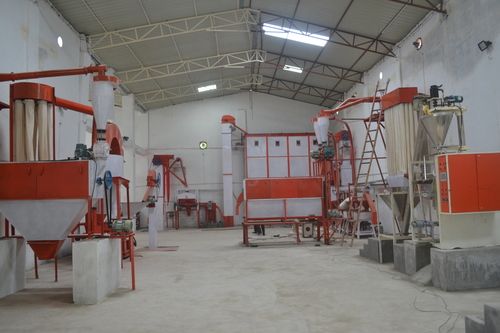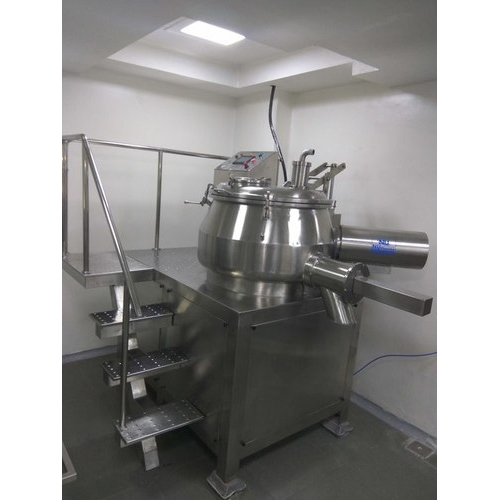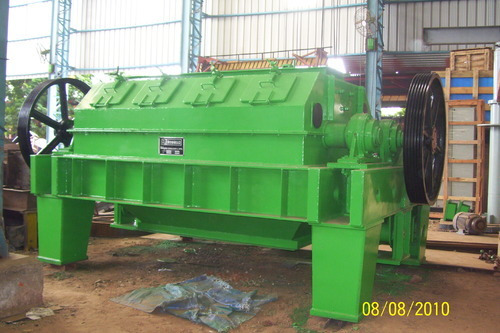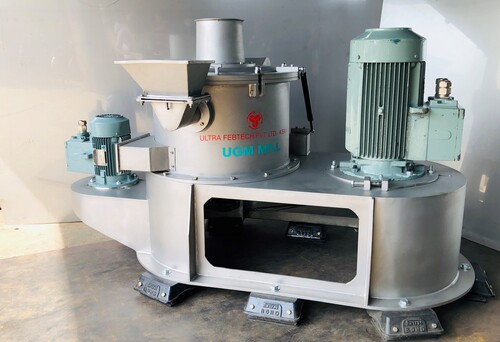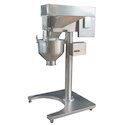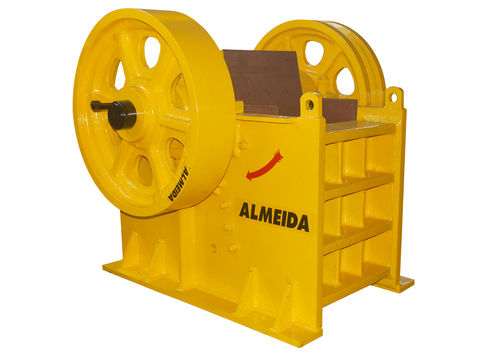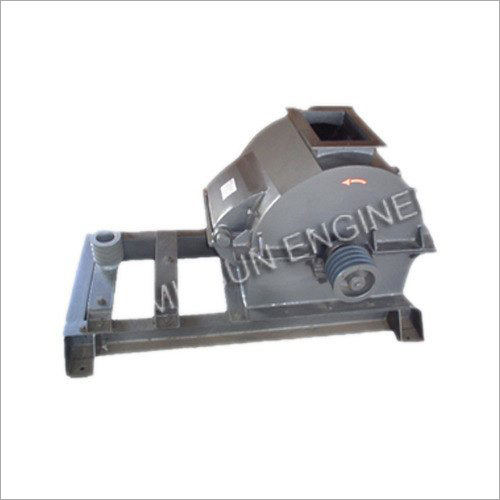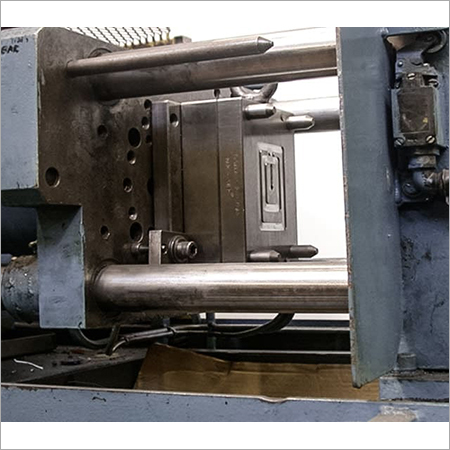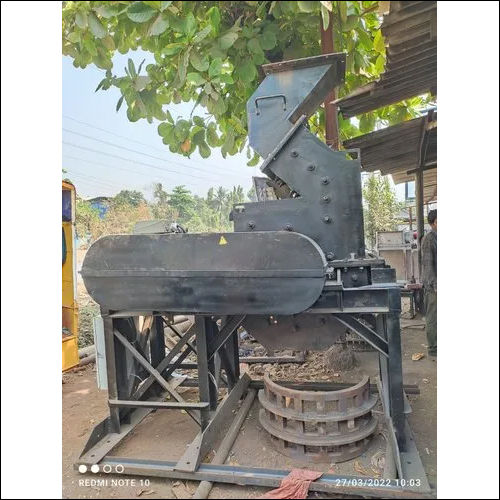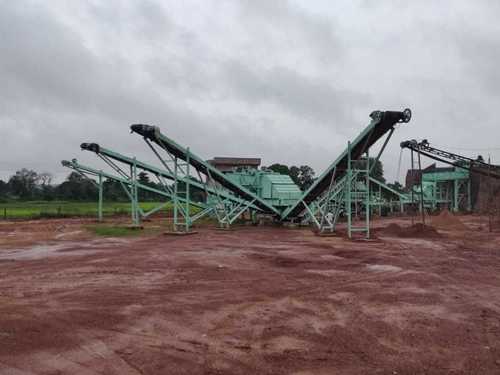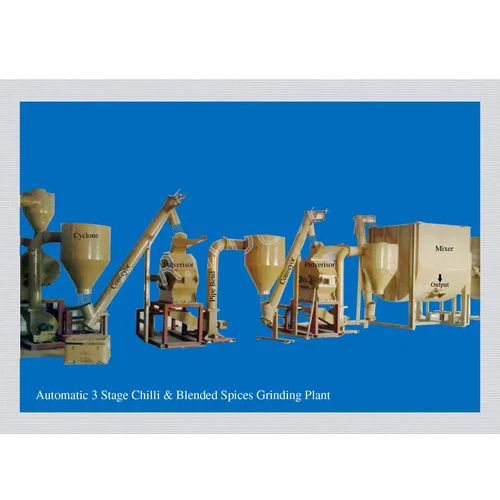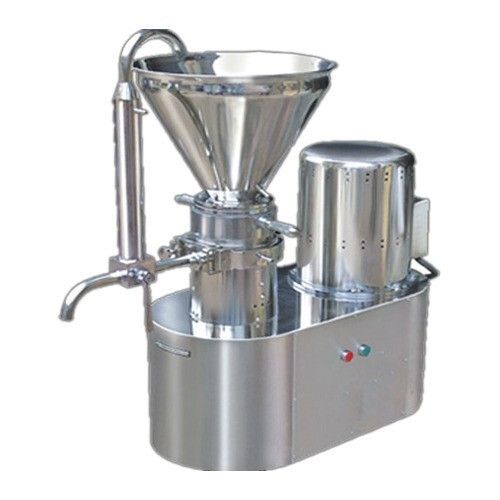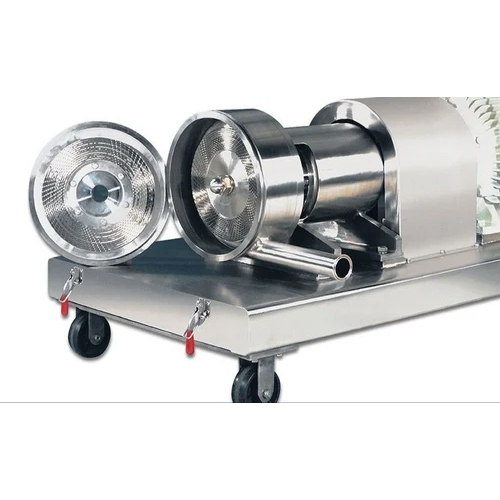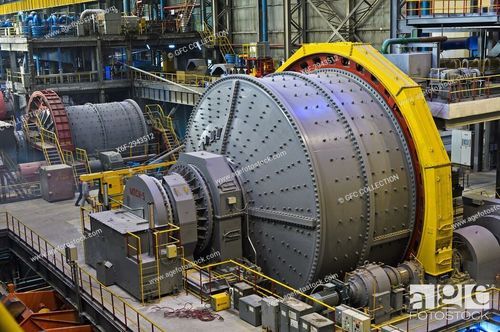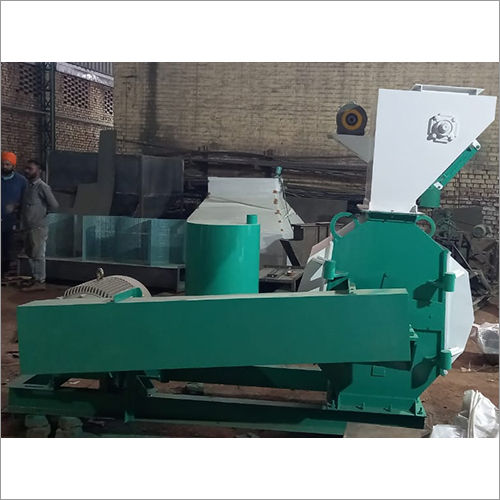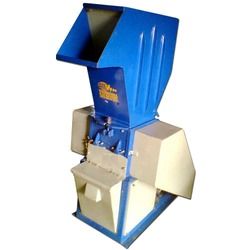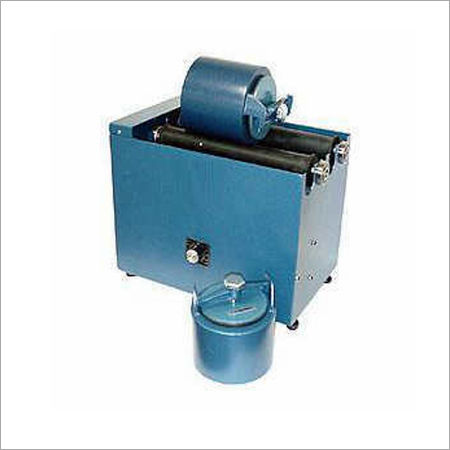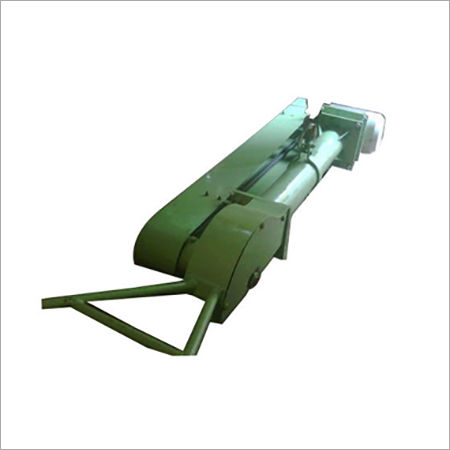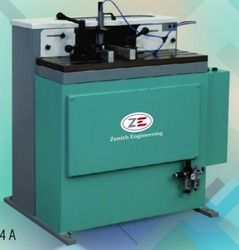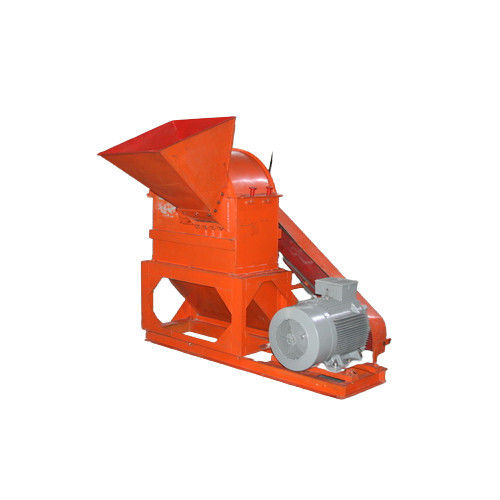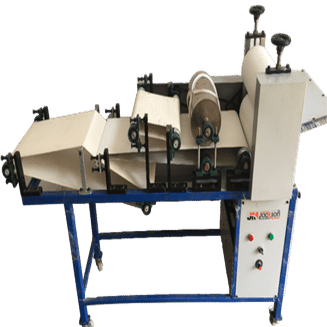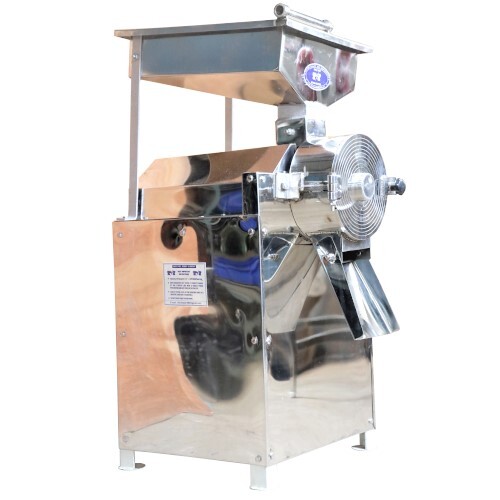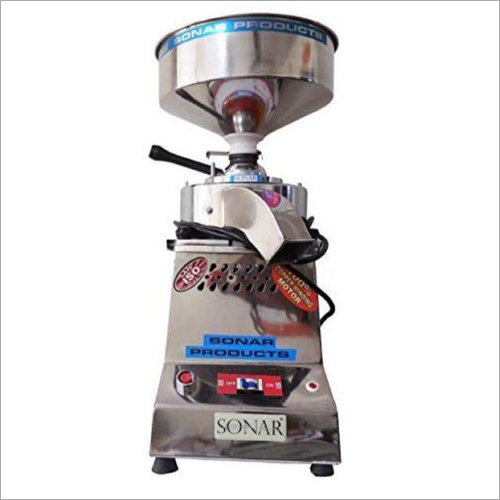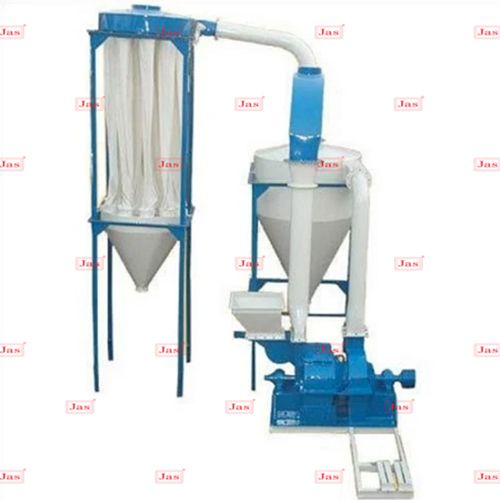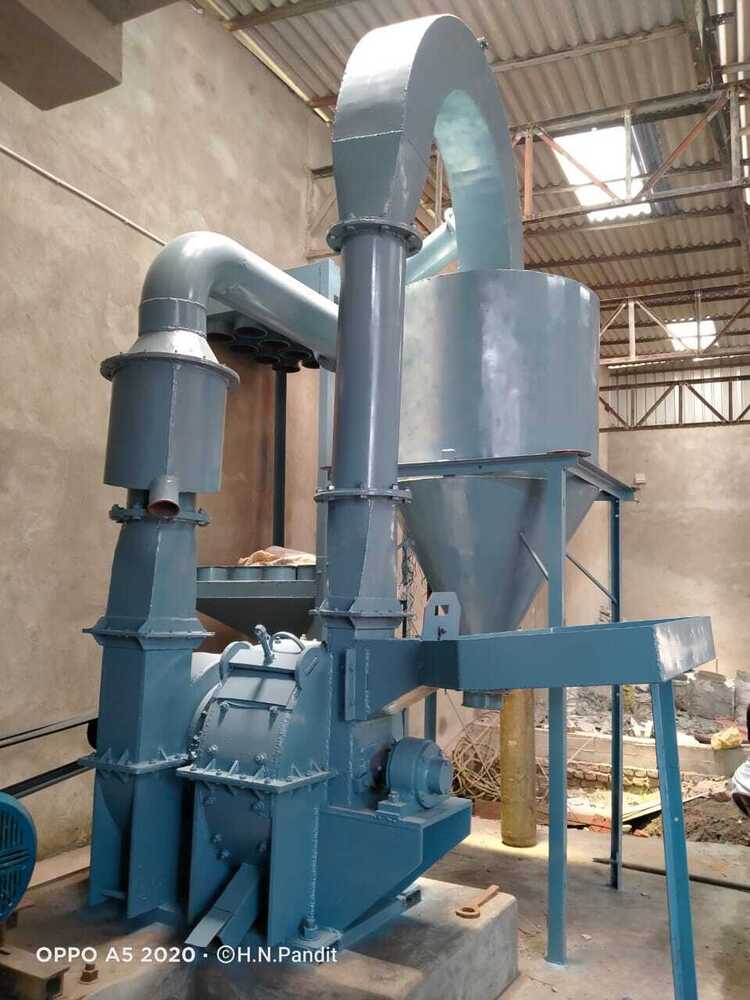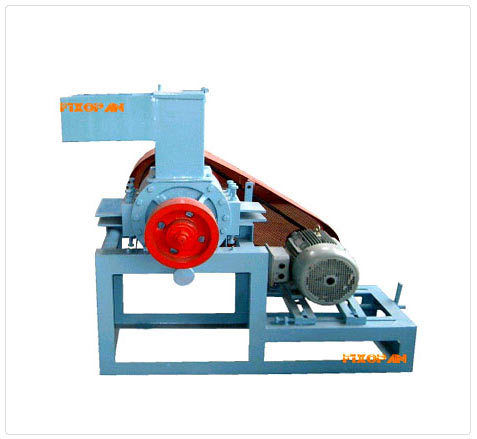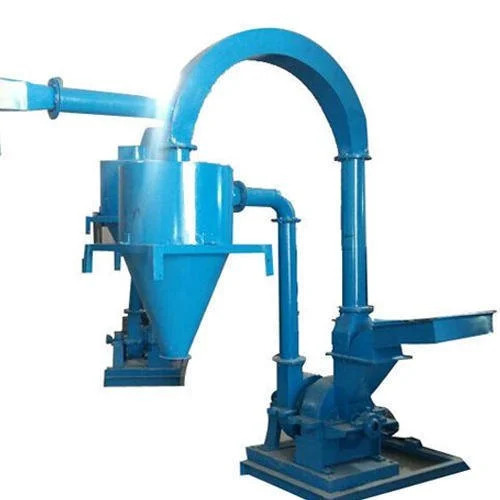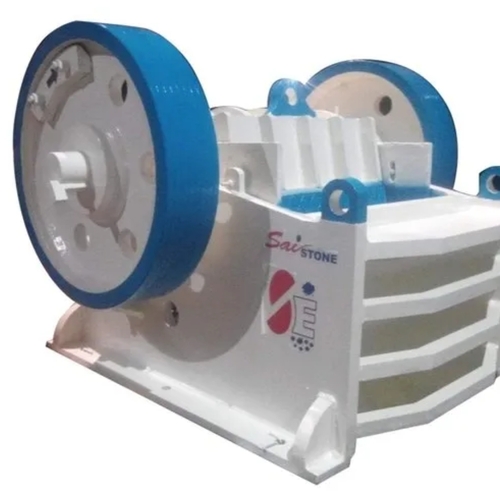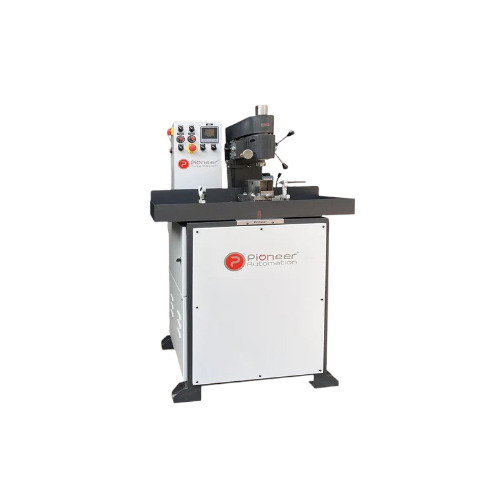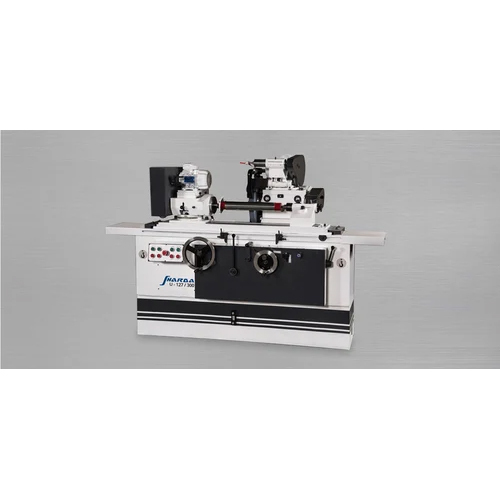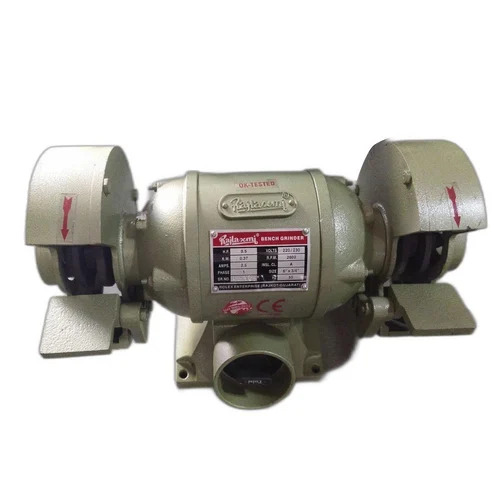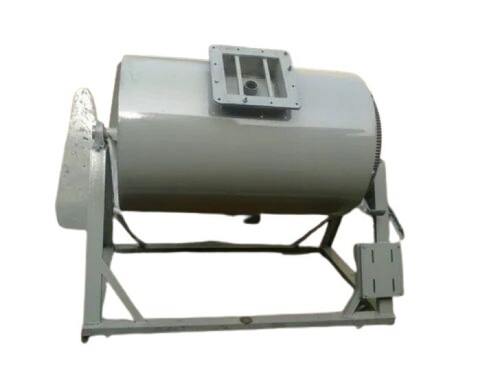Grinding & Milling Machinery
(8475 products)Automatic Flour Mill Capacity: 200-3000 Kg/Hr
330000 INR (Approx.)/Set
MOQ1 , Set/Sets
ColorBlue
Product TypeFlour Mill
TypeFlour Grinding Machine, Grain Processing Equipment
Capacity200-3000 Kg/hr
ComputerizedNo
AutomaticYes
Rapid Mixer Granulator - Capacity: 1500 Liter/Day
Price: 680000.00 INR/Sheet
MOQ1 Set/Sets
ColorOther
Product TypeRapid Mixer Granulator
TypeAbility to blend dry and wet granulation
General UseIndustrial
MaterialStainless Steel
ComputerizedYes
Nu Pharma Engineers & Consultant
Ahmedabad
 Super Bonanza
Super Bonanza12 Years
Double Roll Crushers - Capacity: 350 T/Hr
Price Trend: 600000.00 - 6000000.00 INR/Unit
MOQ1 Unit/Units
UsageIndustrial
Equipment TypeRoll Crusher
Product TypeDouble Roll Crusher
General UseIndustrial
ConditionNew
MaterialMetal
ACM Mill
Price: 1200000 INR/Set
MOQ1 Set/Sets
Sample AvailableYes
Main Domestic MarketAll India
Ultra Febtech Private Ltd.
Ahmedabad
4 Years
 Super Premium
Super PremiumLab Colloid Mill - Stainless Steel Design , High-Efficiency Particle Size Reduction
Price: 80000 INR/Piece
MOQ1 Piece/Pieces
Supply Ability5 Per Month
Delivery Time2-10 Days
Chemech Engineering
Mumbai
21 Years
Jaw Crusher - Color: Yellow
MOQ1 Unit/Units
Product TypeJaw Crusher Machine
General UseIndustrial
ComputerizedNo
AutomaticYes
CNC Or NotNormal
Control SystemPLC Control
Siddharth Engineering Co.
Navi Mumbai
14 Years
 Super Premium
Super PremiumIndustrial Maize Grinding Hammer Mill
Price: 500000 INR/Set
MOQ1 Ton/Tons
ColorBlack
Product TypeHammer Mill
General UseGrinding maize and other grains
MaterialOther, Mild Steel
TypeOther, Maize Grinding Mill
Capacity500-1000 Kg/hr
Mitsun Engineering
Vadodara
21 Years
 Super Premium
Super PremiumDie & Mold Industry - Feature: High Efficiency
MOQ1 Unit/Units
General UseIndustrial
MaterialStainless Steel
ComputerizedNo
AutomaticNo
Control SystemManual
FeatureHigh Efficiency
Precihole Machine Tools Pvt. Ltd.
Bhiwandi
 Super Bonanza
Super Bonanza9 Years
Eco Friendly Amey Hammer Mill For Aluminum Copper Radiators Recycling
Price: 1100000 INR/Piece
MOQ1 Piece/Pieces
ColorOther, Gray
Product TypeAmey Hammer Mill For Aluminum Copper Radiators Recycling
General UseIndustry
MaterialCast Iron
TypeGear Grinding Machine
Control SystemManual
Amey Shredtech Private Limited
Thane
18 Years
 Super Premium
Super PremiumCrusher Plant
Price Trend: 4000000.00 - 15000000.00 INR/Unit
MOQ1 Unit/Units
Product TypeStone Crushing Plant
Moderate Machines (pvt.) Ltd.
Jaipur
14 Years
Spice Processing Plant - Feature: High Performance
Price: 2800000 INR/Set
MOQ1 Set/Sets
Product TypeSpice Processing Plant
General UseIndustrial
MaterialCast Iron
Control SystemPLC Control
FeatureHigh Performance, High Efficiency
B. R. Industries
Hyderabad
15 Years
Colloid Mill - Feature: High Performance
Price: 5000 INR/Unit
MOQ1 Unit/Units
ColorOther, Silver
Product TypeColloid Mill
General UseIndustrial
MaterialStainless Steel
Power5 Horsepower (HP)
Voltage220 Volt (v)
National Analytical Corporation
Mumbai
13 Years
High Efficiency Inline Colloid Mill
Price: 150000 INR/Unit
MOQ1 Unit/Units
ColorOther, Gray
Product TypeInline Colloid Mill
General UseIndustrial
MaterialStainless Steel
ComputerizedNo
AutomaticYes
Innovative Engineering Works
Ahmedabad
 Super Bonanza
Super Bonanza4 Years
 Super Premium
Super PremiumSingle Phase Automatic Surface Grinding Machine
Price: 465000 INR/Unit
MOQ1 Unit/Units
ColorBlue
Product TypeAutomatic Surface Grinding Machine
General UseSurface Grinding
AutomaticYes
Emtex Machinery Private Limited
New Delhi
11 Years
Autogenous Mill - Metal Construction, Long Service Life | High Performance, Automatic, Eco Friendly, Lower Energy Consumption
Price Trend: 100000.00 - 500000.00 INR/Piece
MOQ1 Piece/Pieces
Product TypeGrinding Machine
General UseIndustrial
MaterialStainless Steel
AutomaticYes
FeatureHigh Performance, ECO Friendly, Lower Energy Consumption
Berlin Machineries Private Limited
Pune
5 Years
Grinder With Motor 30 - Cast Iron, 500 Kg Capacity, Green | Automatic, 1-Year Warranty, Powerful & Quiet Motor System
Price: 1500000 INR/Unit
MOQ1 Plant/Plants
ColorGreen
Product TypeGrinder Machine
MaterialCast Iron
TypeFeed Grinding Machine
Capacity500 Kg
AutomaticYes
G S International
Khanna
5 Years
Plastic Scrap Grinder Machine - High-Quality Components and Materials | Cost-Effective and Internationally Compliant
Product DescriptionWe are highly renowned manufacturer and supplier of Plastic Scrap Grinder Machine in Ahmedabad, Gujarat, India. These machines are designed and fabricated using quality components and material to ensure that final output meets with international quality standards. Our offered machines are extensivel
Shreeji Metals
Ahmedabad
7 Years
Stainless Steel Jar Mill
Price Trend: 500000.00 - 5000000.00 INR/Unit
MOQ1 Unit/Units
Product TypeJar Mill
MaterialStainless Steel
AutomaticYes
Control SystemManual
Pratham Engineering
Mira Bhayandar
14 Years
Stainless Steel And Rust Proof Colloid Mill
Price: 5000000 INR/Piece
MOQ1 Piece/Pieces
ColorOther, Silver
Product TypeColloid Mill
MaterialStainless Steel
TypeFeed Grinding Machine, Gear Grinding Machine, Cylindrical Grinding Machine
Capacity150-1500 Kg/day
ComputerizedYes
Bombay Pharma Equipments Pvt. Ltd
Mumbai
4 Years
Swing Frame Grinder - High-Performance Steel | Precision Grinding, Durable Design, Ergonomic Handle
MOQ1 Unit/Units
Supply Ability15 Per Month
Delivery Time3 Week
Hardic Engineering
Ahmedabad
7 Years
 Super Premium
Super PremiumGreen Upvc End Milling Machine
Price Trend: 300000.00 - 500000.00 INR/Piece
MOQ1 Piece/Pieces
Product TypeUPVC End Milling Machine
General UseIndustrial
Weight (kg)220 Kilograms (kg)
ComputerizedNo
AutomaticYes
FeatureECO Friendly, High Efficiency
Zenith Engineering And Equipments Private Limited
Vadodara
11 Years
Heavy Duty Crusher Machine For For Efficient Material Processing Capacity: 1.5-2 T/Hr
Price: 1500000 INR/Unit
MOQ1 Unit/Units
ColorOrange
Product TypeCrushing Machine
General UseCrushing And Shredding
Capacity1.5-2 T/hr
Weight (kg)1000-1200 Kilograms (kg)
FeatureHigh Performance
Jay Khodiyar Machine Tools
Rajkot
20 Years
Jackson Semi Automatic Khakhra Machine 1 Hp Model Namenumber Kmm18, Power: 1 HP
Product DescriptionJackson Semi Automatic Khakhra Machine 1 Hp Model Namenumber Kmm18
Jackson Machine
Ahmedabad
7 Years
 Super Premium
Super PremiumInstant Masala Grinders Capacity: 7-50 Kg/Hr
Price Trend: 72000.00 - 145000.00 INR/Set
MOQ1 Set/Sets
Capacity7-50 Kg/hr
Weight (kg)60-140 Kilograms (kg)
Dimension (L*W*H)40 x 60 x 70 Centimeter (cm)
Thirumalai Industries
Coimbatore
13 Years
Sonar Stone Grinder Capacity: 8 To 16 Kg/Hr
Price Trend: 11500-20000 INR/Piece
MOQ20 , Piece/Pieces
Product TypeStone Grinder
General UseFOR DOMESTIC PURPOSE
MaterialStainless Steel
TypeFeed Grinding Machine
Capacity8 TO 16 Kg/hr
Weight (kg)26 Kilograms (kg)
Sonar Appliances Pvt. Ltd.
Delhi
7 Years
Colloid Mill
Price Trend: 50000.00 - 150000.00 INR/Unit
MOQ1 , Unit/Units
Supply Ability100 Per Month
Delivery Time1 Week
Jicon Technologies Private Limited
Mumbai
22 Years
Turmeric Impact Pulverizer
Price: 238500 INR/Unit
MOQ1 Unit/Units
Main Export Market(s)Asia, Australia, Central America, North America, South America, Eastern Europe, Western Europe, Middle East, Africa
CertificationsISO 9001
Jas Enterprise
Ahmedabad
21 Years
Synchronous Support-Grinding
Product DescriptionWe are a top exporter, manufacturer and supplier of Synchronous Support-Grinding. In Synchronous Support-Grinding, two opposing CBN grinding sheels simultaneously machine the same focal point on the workpiece from opposite sides. eliminating the axial forces generated in feed-in direction. The Synch
Weldor Engineering Pvt. Ltd.
Rajkot
4 Years
Commercial Spice Grinder Machine - Feature: High Performance
Price: 300000 INR/Unit
MOQ1 Unit/Units
Product TypeSpice Grinder Machine
General UseGrinder
MaterialStainless Steel
TypeFeed Grinding Machine
ComputerizedYes
AutomaticYes
Partik Trading Company
Howrah
3 Years
Latest From Grinding & Milling Machinery
Centerless Grinding Machine
By:
Industrial Machinery Corp.
Grinding & Milling Machinery
By:
Shreya Engineers
Grinding And Milling Machinery
By:
Techno Trade
Vertical And Horizontal Milling Machines
By:
Pao Fong Industry Co. Ltd.
Tool Cutter And Grinding Machines
By:
Rajkot Machine Tools
Manual Surface Grinding Machines
By:
G. K. Enterprises
Grinder
By:
Fixopan Machines Pvt. Ltd.
Surface Grinders
By:
Varun Machinery Store
Wet Grinders
By:
Eastern Gas Equipments
Tiles Grinding Machines
By:
Fine Engineering Works
Explore More Cities
Ready To Ship Grinding & Milling Machinery
Grinding & Milling Machinery
Two typical machining operations in the manufacturing sector are milling and grinding. Both of these processes require the removal of material from a workpiece, and they are both capable of working with a broad range of materials. Milling and grinding are two processes that may be used to modify a workpiece no matter what kind of metal or alloy it is made of. This holds true regardless of whether the piece is composed of iron, aluminium, steel, copper, or any other material. However, grinding and milling are not interchangeable terms. Remove material from a workpiece, each of these processes operates uniquely.
Introduction To Grinding & Milling Machinery
A grinding machine, more often referred to simply as a grinder, is a kind of machine tool or power tool that is used for grinding. Machining that employs the use of an abrasive wheel as the primary cutting tool is referred to as abrasive wheel milling. Through a process known as shear deformation, each grain of abrasive that makes up the wheel's surface removes a microscopic chip from the material being worked on.
Difference Between Machining And Grinding
Machining: Machining is generally used for removing large amounts of material (high MRR). Additionally, it has the ability to semi-finish the surfaces. The level of dimensional precision and tolerance that can be attained with these procedures is subpar. It is very challenging to achieve a tolerance of fewer than 2 micrometres. For the purpose of material removal, it makes use of a cutting instrument (also known as a cutter). The most frequent material used in the construction of this cutting tool is metal; however, cutters composed of ceramic, diamond, and cBN are also commercially available. Every cutter has its own unique geometry. This indicates that numerous characteristics, such as angles in various directions, orientations of various planes, the radius of the nose and various edges, etc., are clearly defined. A cutter may have either a positive or a negative rake angle. The value may fluctuate anywhere from 15 degrees in each direction. There is no way for the cutter's clearance angle to be zero or negative. The range of its value is often between +3 degrees and +15 degrees. During machining, each and every cutting edge of the cutter contributes in an equal and equal capacity to the cutting action. During the procedure, shearing is the primary action that takes place. Consumption of specific energy (measured in terms of electricity demanded per unit MRR) is rather low. Only a very small part of the heat created by cutting is absorbed by the work material (between 70 and 80 per cent of the heat is transported away by the moving chips). These techniques are unable to provide a smooth surface finish on hardened materials, as well as materials that are intrinsically highly brittle and tough.
Grinding: This process is usually used for polishing the surface of something. It results in a low MRR. Grinding provides improved dimensional precision as well as a narrow tolerance. It is not difficult to realise a tolerance of 0.5 micrometres or less. The substance is removed with the use of a grinding wheel. The wheel is constructed up of very small, sharp abrasives (such as alumina, silica, and so on) that have been bonded in another medium. Abrasive particles have unpredictable characteristics, despite the fact that the grinding wheel has predefined specifications. Because of this, the angles, orientation, and radius of abrasives, among other characteristics, are not determined. Abrasives have sharp rake angles that may range from plus 60 degrees to minus 60 degrees and even farther than that. Abrasive materials have clearance angles that are sharp as well. It is also possible for it to be negative or zero. Only a small fraction (less than one per cent) of the abrasives that are present on the wheel's perimeter really contribute to the cutting action. The grinding process involves a variety of other operations as well, including rubbing, scraping, ploughing, and shearing. The high specific energy consumption may be attributed to the significant amount of energy that is lost as a result of rubbing, ploughing, and scratching. A significant portion of the heat produced is absorbed by the working material, which results in severe thermal damage to the surface that has been completed. The work material's hardness, ductility, and toughness typically do not provide any difficulties while grinding.
Applications of Grinding & Milling Machinery
For the purpose of grinding various work parts, a sort of instrument known as the grinding machine is employed. The abrasive wheel serves as the primary cutting tool in this system. The abrasive wheel has a rough surface that rips off tiny pieces of the work item in accordance with the specifications. It is also referred to as a grinder in certain circles.
It consists of a bed that has a guide that is set in place to hold the workpiece, as well as a wheel that is power-driven and rotates at a speed that has been specified in advance. The head of the grinder may be positioned to move over a piece of work that is held in place, or the piece of work can be moved while the head of the grinder stays in its current location. A hand wheel or a computerised numeric controller may be used to provide fine-grained control over the position of the table or the grinding head, respectively.
It produces a significant amount of heat, which is why coolants are used to lower the temperature of the workpiece in order to prevent it from overheating, hence avoiding accidents and keeping its tolerance level stable. Because the finishing operations in certain high-precision grinding machines, such as hydraulic cylindrical grinders and surface grinders, create very little heat, coolants are not required because the temperature is manageable.
Types of Grinding & Milling Machinery
Grinders have a variety of applications, including those in the engineering, electrical, automotive, and other sectors. The following is a list of the numerous types of this equipment:
- To accomplish roughing and finishing tasks, a bench grinder is often handled by hand and typically consists of two wheels of varying grain sizes that are set on a floor stand or workbench. Tool bits, as well as other types of tool fabrication and maintenance, are the primary applications for this material.
- Coated abrasives are used in the machining process that is a part of a belt grinder. This procedure grinds many materials, including metals. Belt grinding is a flexible operation that may be used for a variety of purposes, including stock removal and surface finishing, among others.
- Finishing jigs dies, and fittings often requires the use of a jig grinder. It may also be used for grinding difficult surfaces and finishing work. Additionally, it can be used to grind holes. During the production of high-precision gears, a gear grinder is the tool of choice for removing the last few inches of material.
- One kind of cylindrical grinder has a centre, while the other lacks a centre entirely. Cylindrical grinders come in both varieties. There may be more than one grinding wheel attached to a cylindrical grinding machine. In this step, the workpiece is rotated before being put through the wheels, which results in the formation of a cylinder. It finds widespread use in the production of dimensionally correct items like tubes, rods, bushings, bearings, and other components, among other things.
- An effective surface grinder may either be handled manually or by a computer numerically controlled machine. It features a head that may be lowered while the work item is moving back and forth across a table, passing the wheel in between each movement. Both the tool and cutter grinder and the D-bit grinder are capable of performing the duties of a drill bit grinder in addition to other specialised tool room tasks.
FAQs: Grinding & Milling Machinery
Q. What is a grinding and milling machine?
Ans. Mills are devices that reduce the size of solid materials by grinding, crushing, or cutting them into smaller bits. Mills may take the form of structures, machines, or even household appliances. Comminution of this kind is an essential step in a lot of different procedures.
Q. What are grinding and milling machines used for?
Ans. In most cases, the offered materials will be properly shaped and finished with a high-quality surface that has minimal surface roughness with the assistance of a grinder. First and foremost, it is a finishing procedure that involves the removal of very tiny amounts of metal in order to produce extremely exact results.
Q. What are the types of grinding?
Ans. Some of the different types of grinding methods are:
- Thread grinding.
- Gear grinding.
- Contour grinding.
- Centerless grinding.
- Internal grinding.
- Cylindrical grinding.
- Surface grinding.
Q. What is the process of grinding and milling?
Ans. Milling and grinding are two distinct processes, despite the fact that they both require the elimination of material from the surface of a workpiece. The first method of machining, known as milling, is distinguished from the second method, known as grinding, by the fact that the former makes use of a milling machine while the latter makes use of a grinding wheel.
Manufacturers & Suppliers of Grinding & Milling Machinery
Company Name | Member Since |
|---|---|
Jicon Technologies Private Limited Mumbai, India | 22 Years |
Chemech Engineering Mumbai, India | 21 Years |
Mitsun Engineering Vadodara, India | 21 Years |
Jas Enterprise Ahmedabad, India | 21 Years |
Jay Khodiyar Machine Tools Rajkot, India | 20 Years |
Amey Shredtech Private Limited Thane, India | 18 Years |
Ecoman Vadodara, India | 15 Years |
B. R. Industries Hyderabad, India | 15 Years |
Siddharth Engineering Co. Navi Mumbai, India | 14 Years |
Moderate Machines (Pvt.) Ltd. Jaipur, India | 14 Years |
Popular Products

